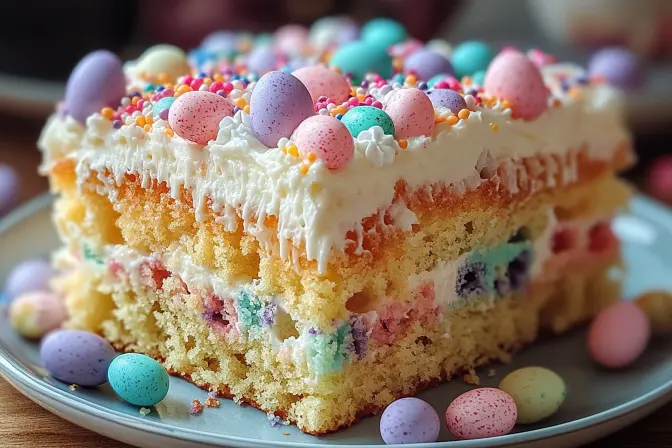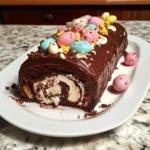Description
This Easter Poke Cake is a vibrant and delightful dessert, perfect for celebrating spring and the Easter holiday. Imagine a moist, fluffy white cake infused with swirls of colorful, fruity gelatin, topped with a cloud of whipped cream, and adorned with festive sprinkles. It’s a visual masterpiece that’s as fun to make as it is to eat! This recipe takes a classic poke cake concept and elevates it with bright, pastel hues and a touch of Easter whimsy. It’s incredibly easy to prepare, making it a fantastic option for family gatherings, potlucks, or a special treat for your loved ones. The combination of the soft cake, jiggly gelatin, and creamy topping is a textural dream, offering something for everyone to enjoy.
Why You Will Love This Recipe
There are so many reasons to fall in love with this Easter Poke Cake! First and foremost, it’s a showstopper. The vibrant colors are instantly appealing, making it the perfect centerpiece for your Easter dessert table. Secondly, it’s incredibly moist and flavorful, thanks to the gelatin seeping into every nook and cranny of the cake. The process of poking the holes and watching the gelatin soak in is surprisingly satisfying.
Moreover, this recipe is highly customizable. You can easily swap out the gelatin flavors to match your preferences or create unique color combinations. Feel free to experiment with different toppings, such as fresh berries, chocolate shavings, or even a drizzle of white chocolate ganache. It’s a blank canvas for your creativity!
Finally, it’s a guaranteed crowd-pleaser. Kids and adults alike will be captivated by its appearance and delicious taste. This Easter Poke Cake is more than just a dessert; it’s a celebration of spring, joy, and shared moments.
Ingredients:
- 1 box white cake mix (plus ingredients listed on the box, such as eggs, oil, and water)
- 1 package (3 oz) strawberry gelatin (or any pastel-colored gelatin like lemon, lime, or berry blue)
- 1 package (3 oz) lime gelatin (or another contrasting pastel color)
- 2 cups boiling water (1 cup per gelatin flavor)
- 1 container (8 oz) whipped topping (Cool Whip or homemade whipped cream)
- 1 cup sweetened shredded coconut (optional)
- Pastel food coloring (pink, yellow, green, blue – optional)
- Easter sprinkles or mini chocolate eggs for decoration
Preparation:
Step 1: Bake the Cake:
- Preheat your oven to 350°F (175°C). This is the ideal temperature to ensure the cake bakes evenly and rises properly.
- Grease a 9×13-inch baking dish. Use cooking spray or butter to prevent the cake from sticking to the pan. This will make it easier to remove the cake later and will ensure it looks beautiful when served. If you are using butter, dust the buttered pan lightly with flour for extra insurance against sticking.
- Prepare the cake batter: Follow the instructions on the cake mix box, mixing the eggs, oil, and water as directed. It is best to follow the package instructions to ensure that your cake results in a perfectly baked result. Pay close attention to the mixing times; over-mixing can lead to a tough cake, while under-mixing can result in an uneven texture.
- Bake the cake: Pour the batter into the prepared dish and bake according to the package instructions (typically 25-30 minutes) or until a toothpick inserted in the center comes out clean. Start checking for doneness around the 25-minute mark. If the toothpick comes out with wet batter, continue baking for a few more minutes and check again. Avoid opening the oven door too frequently, as this can cause the cake to collapse.
- Cool the cake: Let the cake cool in the pan for about 15 minutes. Cooling the cake slightly will help it to retain its shape when you poke the holes. It also allows the steam to escape, which prevents the cake from becoming soggy.
Step 2: Poke and Fill the Cake:
- Poke holes: Using the handle of a wooden spoon or a fork, poke holes all over the cake, spacing them about 1 inch apart. Ensure you poke deep enough to create cavities for the gelatin to fill. Be careful not to poke all the way through the bottom of the cake. The more holes you poke, the more gelatin will seep into the cake, resulting in a moister and more flavorful dessert.
- Prepare the gelatin: In separate bowls, dissolve each gelatin flavor in 1 cup of boiling water. Stir until fully dissolved. This is a crucial step to ensure the gelatin sets properly. Make sure there are no granules left undissolved. Stirring constantly will speed up the process and prevent clumping.
- Pour the gelatin: Carefully pour each gelatin flavor over different sections of the cake, alternating colors to create a marbled effect. Use a spoon to help distribute the gelatin evenly into the holes. Allow the gelatin to soak into the cake gradually. Avoid pouring too much gelatin in one spot, as this can cause it to overflow.
- Chill the cake: Cover and refrigerate for at least 2 hours to allow the gelatin to set. This is essential for the cake to hold its shape and for the gelatin to achieve the right consistency. Chilling overnight is even better, as it allows the flavors to meld together even more.
Step 3: Decorate the Cake:
- Spread the whipped topping: Evenly spread the whipped topping over the chilled cake. Use a spatula or knife to create a smooth, even layer. If you are using homemade whipped cream, make sure it is stabilized to prevent it from weeping.
- Add coconut (Optional): If using coconut, toss it with a few drops of pastel food coloring and sprinkle over the cake. This adds a touch of visual appeal and a subtle coconut flavor. You can customize the colors of the coconut to match your Easter theme. Alternatively, you could toast the coconut lightly in a dry pan for a more intense flavor.
- Garnish: Top with Easter sprinkles, mini chocolate eggs, or your favorite festive decorations. Get creative with your decorations and personalize the cake to your liking. You can also use fresh berries, edible flowers, or even a drizzle of melted chocolate.
COOKING Rating:
Easy
Serving Suggestions:
- Serve chilled for a refreshing and delightful dessert.
- Pair with a scoop of vanilla ice cream or a dollop of extra whipped cream.
- Garnish with fresh berries or a drizzle of white chocolate.
- Serve as part of an Easter buffet or a springtime celebration.
Tips:
- For a more intense flavor, use flavored extracts in the cake batter.
- To prevent the cake from becoming soggy, don’t over-saturate it with gelatin.
- For a prettier presentation, use different pastel-colored gelatins.
- If you don’t have time to make homemade whipped cream, Cool Whip is a great alternative.
- Store leftover cake in the refrigerator for up to 3 days.
Prep Time:
20 minutes
Cook Time:
25-30 minutes
Total Time:
Minimum 2 hours 45 minutes (including chilling time)
Nutritional Information:
(Approximate, per serving)
- Calories: 250-300 kcal
- Protein: 3g
- Fat: 10g
- Carbohydrates: 40g
- Sodium: Varies depending on the cake mix and gelatin used.
Conclusion
This Easter Poke Cake is a show-stopping dessert that is sure to impress. It’s easy to make, customizable, and bursting with flavor. The combination of the moist cake, fruity gelatin, and creamy topping is simply irresistible. Whether you’re celebrating Easter, spring, or just want a fun and festive treat, this poke cake is the perfect choice. Enjoy the process of creating this vibrant dessert and sharing it with your loved ones. It’s a recipe that’s bound to become a tradition in your family.
Questions and Answers about this Recipe
Q1: Can I use sugar-free gelatin in this recipe?
A: Absolutely! Using sugar-free gelatin is a great way to reduce the sugar content of this dessert without sacrificing flavor or texture. Keep in mind that sugar-free gelatin may have a slightly different consistency, so be sure to follow the package instructions carefully. You might also want to consider adding a touch of sweetener to the whipped topping to compensate for the lack of sugar in the gelatin.
Q2: What if I don’t have a white cake mix? Can I use another type of cake mix?
A: Yes, you can definitely use another type of cake mix. A yellow cake mix will give the cake a richer flavor and color. A lemon cake mix would complement the lime gelatin beautifully, adding a bright, citrusy note. Even a vanilla cake mix would work well. Just be mindful that the flavor profile of the cake will change depending on the mix you choose.
Q3: Can I use fresh fruit instead of gelatin?
A: While using fresh fruit in the traditional poke cake method isn’t as effective as gelatin (which soaks into the cake), you can incorporate fruit in other ways! Instead of poking and filling with gelatin, consider poking holes and filling them with a fruit curd (like lemon curd) or a homemade fruit compote that’s been slightly thickened. You could also top the cake with a layer of whipped cream and arrange fresh fruit artistically on top. Just know that the texture and overall experience will be different.
Q4: How can I make this cake ahead of time?
A: This is a perfect make-ahead dessert! You can bake the cake and add the gelatin up to 2 days in advance. Cover it tightly with plastic wrap and store it in the refrigerator. However, wait to add the whipped topping and decorations until just before serving. This will prevent the whipped topping from becoming soggy or the decorations from losing their vibrancy.
Q5: Can I use homemade whipped cream instead of Cool Whip? What’s the best way to stabilize it?
A: Yes, homemade whipped cream is a wonderful alternative to Cool Whip! It adds a richer, more decadent flavor to the cake. However, homemade whipped cream tends to be less stable, so it’s important to stabilize it to prevent it from weeping or deflating. One way to stabilize whipped cream is to add a tablespoon of powdered sugar per cup of heavy cream. You can also add a small amount of gelatin. To do this, dissolve 1/2 teaspoon of unflavored gelatin in 1 tablespoon of cold water. Let it sit for 5 minutes to soften, then microwave for 10-15 seconds until melted. Let it cool slightly, then whisk it into the heavy cream before whipping. This will help the whipped cream hold its shape for a longer period.




